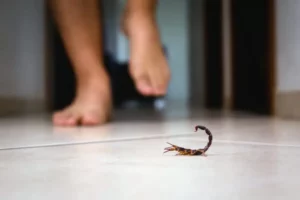Home / Blog / Drain Flies 101: Identifying, Preventing, and Eliminating Those Pesky Bathroom Bugs
Drain Flies 101: Identifying, Preventing, and Eliminating Those Pesky Bathroom Bugs

Scientifically reviewed by Rachel Maldonado
-Published on February 9, 2024
-Updated on September 1, 2025
Drain Flies 101: Identifying, Preventing, and Eliminating Those Pesky Bathroom Bugs
Have you spotted any tiny, moth-like insects flitting around your bathroom? Or worse: are they hovering around your face while you’re trying to brush your teeth or take your morning shower?
It’s time to take action. These annoying little guys are called “drain flies.” They’re pretty tiny, so they may seem innocent, but these pests can become a serious nuisance if they start to multiply by laying eggs in your drains and pipes. It’s important to stamp them out before they start.
We’ll help you get rid of drain flies for good. It starts with understanding how to recognize these little pests, then taking the right professional steps to prevent them. Let’s get started.
Identifying Drain Flies
Drain flies—sometimes also known as moth flies or sewer gnats—are a common sight in many homes. They are tiny insects, only measuring about ⅛ inch in length, and have a slightly fuzzy appearance due to their body and wings being covered in minuscule hairs. They have three pairs of legs and two wings on their body, which are covered in a unique pattern of gray and black spots. (But you can really only see this decoration under a microscope. To the naked human eye, they just look like a little black bug flying all over your personal space.)
We often spot these winged creatures near dark, moist environments, such as near the sink, shower, or bathtub. That’s because these flies usually breed in stagnant water or in decaying organic matter, so they congregate and reside inside drain pipes, sink traps, or dirty garbage disposals.
One common misconception about drain flies is that they are fruit flies or gnats. But it’s important to note the key differences between these pests. Fruit flies are slightly larger than drain flies and are more commonly discovered hovering around overripe or rotting fruit or an unsealed compost bin. Gnats, meanwhile, are typically found near potted plants and in nature. You won’t usually find either of them inside of a bathroom drain—that’s drain fly territory.
Drain flies are not harmful to humans. But that doesn’t mean their presence isn’t disconcerting and downright annoying.
About Drain Fly Habits
As we noted above, drain flies are attracted to moist and damp areas, as well as areas with decaying organic matter like drains, standing water, the garbage disposal, and wet compost piles.
Drain flies breed quickly in these environments and can create large populations within a short period.
They have an approximate lifespan of two to three weeks. Their life cycle has four stages: egg, larva, pupa, and adult. It starts when females lay their eggs in moist areas, such as sink drains, where organic matter is present. The eggs hatch into larvae, which feed on organic material until they reach the pupa stage. After a few days, the pupae emerge as adult drain flies.
It’s important to hire proper pest control to keep their breeding and any subsequent serious infestation at bay.
How to Prevent Drain Fly Infestations
Little drain flies might seem harmless because they’re so small, but they can quickly infest your home or apartment with what feels like an unmanageable amount of tiny bugs flying everywhere. So how do you keep them away before they can move in?
- First, keep your drains clean and clear. Drain flies thrive in damp, dirty places, so make sure you frequently clean your drains with a combination of vinegar and baking soda
- Regularly clean the underside of the garbage disposal splash guard. This will break up any clogs and eliminate any sludge that might be attracting drain flies.
- Keeping your pipes in good working order is another essential step in avoiding drain fly infestations. Fix any leaky faucets or pipes, and make sure your plumbing is up to code. Any standing water is an invitation for these pesky little critters to lay their eggs.
Eliminating Drain Fly Infestations to Take Back Your Space
If you’re dealing with a full-blown infestation of drain flies and vinegar & baking soda isn’t doing the trick, it may be time to turn to something stronger. Commercial drain cleaners can be more effective, especially when used with a hard-bristle drain brush. You may also have to snake your drain first to remove any buildup of organic matter.
Send Drain Flies Down The Drain!
Now you can identify, prevent, and eliminate those irritating bathroom bugs known as drain flies. Ultimately, the key to keeping your home free from flies is to keep it very clean. Fix leaks, get rid of any lingering moisture, and clean your drains on a regular basis to keep these bugs at bay.
Generally, insecticides are not usually necessary for drain fly management. But, if you’re having trouble dealing with an infestation, it’s important to know when to throw in the towel and call in the professionals. Hawx Pest Control Services has the know-how and tools to handle the toughest pest situations. If that’s what you’re dealing with, don’t wait to give us a call and join our family of satisfied customers today!
Related Articles
Visit our blog to learn more.
→








